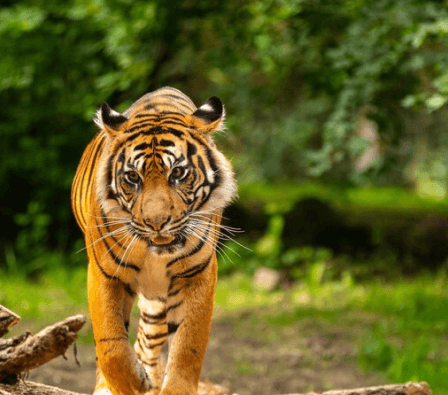Welcome to the enchanting realm of Renuka Wetland, nestled in the serene Sirmaur district of Himachal Pradesh, India.
However, situated at an elevation of 672 meters above sea level, this breathtaking expanse is crowned as the largest lake in Himachal Pradesh, boasting a majestic circumference of approximately 3214 meters.
Named after the revered goddess Renuka, this Renuka Wetland Ramsar site has held profound cultural significance since November 2005.
Connected by well-paved roads, it lies just 123 kilometres from Parwanoo, 60 kilometres from Paonta Sahib, and 37 kilometres from Nahan, spanning a lush area of 20 hectares.
Shaped like a slumbering woman, Renuka Wetland, Himachal Pradesh, harbours a poignant myth within its waters, recounting the tale of Renuka’s demise at the hands of her son, the legendary Parsu Ram.
Fed by 21 seasonal streams, this perennial water body remains a haven of tranquillity, nurtured by internal springs that whisper tales of eternal grace.
Location

However, situated approximately 123 kilometres from Parwanoo, this natural wonder beckons travellers with its serene ambience and abundant biodiversity.
For those journeying from Paonta Sahib, a scenic route via Sataun spanning 51 kilometres unfolds, while a mere 38-kilometre drive awaits visitors from Nahan.
Upon arrival, visitors are greeted by the mesmerizing sight of Renuka Lake, the largest natural lake in Himachal Pradesh, serving as the centrepiece of the wetland ecosystem.
Besides its scenic allure, the Renuka wetland area is renowned for its affluent avian population, making it a haven for birdwatching enthusiasts.
Moreover, the surrounding hills and forests offer ample opportunities for trekking and nature walks, further enhancing the allure of this idyllic destination.
Legend

On the eve of Prabodhini Ekadashi, the serene shores of Renuka Wetland in Himachal Pradesh come alive with the fervent devotion of pilgrims, drawn by the mythical tale of Renuka and her son, Parashurama.
As the five-day Renuka fair commences, echoing with the ancient chants and rituals, devotees gather from across the nation to witness the sacred reunion.
According to revered scriptures, Renuka, accompanied by her husband Maharishi Jamadagni, meditated devoutly at Tape Ka Tiba, birthing Parashurama through divine blessings.
Tragically, her transformation into the Renuka lake, following her ultimate sacrifice, forms the backdrop of this timeless legend.
Each year, on Dashami, Parashurama’s palanquin embarks on a grand ‘Shobha Yatra’, culminating in his arrival at Renuka, where devotees await the poignant encounter between mother and son.
Amidst the vibrant festivities and solemn rituals, the divine presence of Renuka is palpable, blessing her adherents and reaffirming the sacred bond that transcends time and mortality.
Sanctuary

Situated in the picturesque Sirmour district of Himachal Pradesh, the Renuka Wetland Sanctuary beckons with its natural splendour.
Easily accessible via a network of motorable roads, this sanctuary spans approximately 4.028 km2.
Comprising the Renuka Reserve Forest, it has been designated as Abhayaranya, with an additional 3 km2 outside the sanctuary marked as a buffer belt.
Notably, the sanctuary encompasses the breathtaking Renuka Wetland, adding to its ecological significance. Visitors can revel in the diverse flora and fauna while soaking in the serene ambience.
Additionally, from bustling city life, a journey here promises tranquillity and nature’s embrace. However, you can explore Himachal Pradesh’s honeymoon places more.
Threats

Renuka Wetland faces imminent threats stemming from its diminishing size, primarily caused by the continuous deposition of silt.
Locals and administrative authorities alike are deeply concerned about this alarming trend. The soil accumulation from rainwater and landslides in the neighbouring mountains exacerbates the situation.
Moreover, the persistent dumping of construction waste into the lake poses a significant environmental hazard.
However, amidst these challenges, the Administration and Renuka Vikas Smiti remain resolute in safeguarding the lake’s ecological integrity.
Notably, the proactive measure of banning plastic bags across the region underscores the collective commitment to conservation.
Climate

The climate at Renuka Wetland embodies the characteristics of a subtropical monsoon. Annually, the region experiences an average precipitation ranging between 150 to 199.9 cm.
Maximum temperatures hover around 30°C. Winters are gentle in lower elevations but see snowfall in the lofty mountain ranges.
Springs greet with warmth and sunshine, while the rainy season blankets the area with its highest humidity and frequent showers.
Summers, especially during the monsoon months, become uncomfortably hot. Additionally, from one season to another, Renuka Wetland offers a diverse climate, each season with its unique charm and challenges.
Geology

The geological makeup of Renuka Wetland encompasses a rich array of formations, primarily consisting of dark carbonaceous shales and slates.
These are intricately interspersed with thin, slaty quartzite layers from the Infra Krol Group.
Furthermore, the composition reveals calcareous elements alongside quartz, sericite, and pyrite, sometimes accompanied by chlorite.
Another significant geological aspect is the presence of green-grey calcareous shale and argillaceous limestone from the Krol A Group.
At the same time, the Krol B Group introduces purple-red shales with intermittent green-shale layers and thin dolomitic cherty limestone.
The region also boasts Krol C’s well-bedded greyish-white limestone and shale formations.
Dating back to the neo-Proterozoic to Proterozoic era, the geological strata provide a fascinating glimpse into the region’s past. Moreover, the soil composition mirrors this diversity, blending carbonate rocks, sandstones, shales, and siltstones. However, the soil cover remains relatively thin due to limited weathering conditions.
Flora and Fauna

Renuka Wetland boasts an astonishing array of flora and fauna, showcasing over 440 species, from protozoa to mammals.
Enveloped in a sub-tropical forest, the wetland is adorned with a lush vegetation landscape featuring Chhal, Sain, Bahera, Harar, Kachnar, Tun, Shisham, & Amaltas, among others.
However, a natural Sal forest thrives towards the northern expanse, adding to the wetland’s ecological diversity.
Despite its modest size of five hundred hectares, the Renuka catchment is a sanctuary for a diverse wildlife population.
From Ghoral and Kakkar to Chital and Hare, along with the occasional sighting of Porcupine, Black Bear, Monkey, and Langur, the area pulsates with life.
Moreover, the wetland hosts a thriving aquatic ecosystem boasting an impressive variety of fish and tortoise species.
Moreover, Renuka Wetland is gradually emerging as a haven for local and migratory bird species.
Pheasants, partridges, parrots, and jungle fowl are among the resident bird groups, enhancing the wetland’s allure as a birdwatcher’s paradise.
Conclusion
In conclusion, Renuka Wetland is a testament to the delicate balance between myth and ecology, tradition and conservation.
Efforts to preserve this natural wonder must be steadfast and collaborative. While the site teems with biodiversity and cultural significance, it faces threats from silt deposition and pollution, necessitating immediate action.
The convergence of pilgrims, birdwatchers, and nature enthusiasts underscores its multifaceted appeal.
Furthermore, initiatives such as Renuka Vikas Smiti’s conservation endeavours and the ban on plastic bags signify progress towards sustainable stewardship.
However, continued vigilance and community engagement are paramount to safeguarding Renuka Wetland’s ecological integrity for future generations.
FAQ
Q. Where is Renuka Wetland located?
A. Renuka Wetland is approximately 37 kilometres northeast of Nahan, the administrative centre of the Sirmaur district in Himachal Pradesh.
Q. What is Renuka Lake famous for?
A. Renuka Lake, shaped like a woman’s profile, is the largest in Himachal Pradesh, with a circumference of 2.5 kilometres. It is revered for its mythological significance as the embodiment of Renukaji, the wife of sage Jamadagini.
Q. Which river flows through Renuka Wetland?
A. A small stream originating from the lower Himalayan slopes flows through Renuka Wetland, eventually joining the Giri River, sustaining the ecosystem of this natural marvel.
Q. Which state is Renuka Dam located in?
A. Renuka Dam was constructed on the Giri River in Himachal Pradesh.










